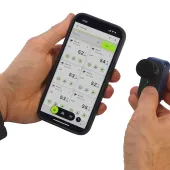How accurate is the sound level meter or seismograph that you are using?

First published in the May 2018 issue of Quarry Management as Aiming for Accuracy
Andy Maslin, director of Accudata Ltd, looks at the issue of inaccurate equipment and highlights the need for independently accredited calibration
If environmental monitoring equipment is inaccurate, measurements taken with it are as good as worthless. Equipment accuracy may not be given too much consideration when making a purchase. Specifications may be a driving force and precision assumed, with buyers tending to rely on manufacturers’ claims regarding accuracy.
Sound level meters that are mass-produced in the Far East can be bought on the Internet for as little as £10, but recognized makes of sound level meters are designed and built to meet exacting international standards, such as IEC61672. The price of these instruments is likely to be many hundreds if not thousands of pounds. Precision and stability are key to cost, and a manufacturer’s calibration certificate may be supplied with the sound level meter to assure the purchaser of the unit’s accuracy.
Many less-costly sound level meters are sold with claims that they meet a build standard and a class of accuracy that they patently do not, nor ever could do. For example, microphone capsules meeting Type 1 accuracy of IEC61672 will normally be priced at £500 or more, just for the capsule. The pre-amplifier may well be an additional £200 and the meter itself £2,000 to £3,000.
Seismographs (blast monitors) currently have no national or international build standards, so manufacturers build or try to build their instruments so that they will accurately monitor in compliance with the relevant methodology standards, such as BS:7385 Part 2, 1993 and BS:5228 Part 2, 2009. A manufacturer’s certificate of calibration will almost always accompany a newly purchased blast monitor.
It is, however, worth remembering that all that is needed to provide a calibration certificate is a piece of paper and a pen. An accredited calibration by an independent laboratory is a sensible choice if accuracy is paramount. UKAS is the UK’s National Accreditation Body. It is responsible for ‘determining, in the public interest, the technical competence and integrity of organizations such as those offering testing, calibration and certification services’. Traceability is the main criterion for ensuring accuracy of calibration. A UKAS-accredited calibration laboratory will provide a trustworthy service and provide a calibration certificate that is traceable and a true reflection of the instrument’s accuracy. There are many UKAS-accredited laboratories offering calibration of sound level meters.
For seismographs, however, there is no UK-accredited body able to offer calibration of the velocity sensors (geophones) that these devices employ. There is, however, a laboratory in Europe that does hold accreditation. This laboratory was, in 2014, awarded ILAC accreditation to the ISO/IEC 17025 Norm. It is the first company in the world to earn the highest level of accreditation for seismograph velocity transducer calibration. It took the laboratory almost five years to achieve accreditation and, needless to say, hundreds of thousands of euros in test equipment and set-up costs.
A blast-monitoring seismograph for use in the UK must be able to measure peak particle velocity (PPV) in mm/s from 4Hz up to 100Hz. The frequency response should be as linear as possible in each of the three axes. Figure 1 is from a calibration certificate showing the vertical channel response of a seismograph calibrated in October 2017. The vertical channel of this seismograph has an almost perfectly linear response between 4Hz and 100Hz. To be acceptable, any deviation must be within the upper and lower blue lines. In this example, the other two axes, transverse and radial, also had a very similar linear response.
Since its accreditation in 2014, the European laboratory mentioned above has calibrated many makes and models of seismographs currently available. The seismographs from the world’s two largest manufacturers are very accurate and meet the required specifications well. However, the lab has seen a few astonishingly inaccurate instruments from manufacturers whose specifications claim to meet, in full, the parameters necessary for accurate monitoring in compliance with methodology standards.
The results in figure 2 show the vertical response of one such widely available seismograph. The blue line indicates where the red line should be in order to achieve ideal linearity. The other two axes each showed a similar response.
Accuracy, particularly between 4Hz and 50Hz, is essential in order to avoid damage to property or structures. The non-linear readings made by the seismograph shown in figure 2 mean that, in practice, any measurements made will be far lower than the true levels of vibration.
In the above case, the laboratory stated that, in its opinion, the electronics used in the seismograph would never enable it to achieve a linear response. Instead of using digital signal processing, it appeared to use the direct output from the 4½Hz geophones through an analogue-to-digital converter, using resistors as a means of adjustment.
In summary, if there is a suspicion that monitoring equipment is inaccurate or there is any doubt about manufacturer’s calibration techniques, an independent accredited laboratory should be used.
- Subscribe to Quarry Management, the monthly journal for the mineral products industry, to read articles before they appear on Agg-Net.com








